When a child loses a limb, it doesn’t just affect their body—it touches every part of their world. For parents, caregivers, and children alike, the journey to adapting to life with a prosthetic is filled with questions, emotions, and learning curves. One of the biggest challenges is making sure the prosthetic continues to fit well as the child grows.
Kids grow fast. Their bones, muscles, and bodies change constantly. A prosthetic that fit perfectly six months ago might start causing discomfort today. That’s why regular adjustments are not just helpful—they’re essential. But how do you know when to make these changes? And what’s the best way to make sure your child is always comfortable, confident, and able to move freely?

Understanding Growth and Its Impact on Prosthetics
Every child grows at their own pace. Some have sudden growth spurts, while others grow steadily over time. As exciting as this is, it also means their prosthetic needs to keep up.
A prosthetic is not like a regular piece of clothing that you can just replace when it gets tight. It has to move with the body, support weight properly, and stay secure without causing pain.
When a prosthetic doesn’t fit right anymore, it can rub against the skin, create pressure points, or even affect how your child walks or uses their hand.
That’s why understanding how growth impacts a prosthetic fit is the first and most important step.
The Signs of an Improper Fit
Sometimes, it’s not easy to know when a prosthetic needs adjusting. Children may not always be able to explain what’s wrong, especially if they’ve gotten used to the discomfort.
As a parent or caregiver, watching for small changes can make a big difference.
You might notice your child taking the prosthetic off more often than usual or saying it feels “weird” or “tight.” Red marks on the skin, swelling, or changes in how they walk or use the limb are clear signs that the fit needs attention.
Some kids may also stop using the prosthetic as much because it just doesn’t feel right anymore.
This is where routine check-ups matter. At Robobionics, we recommend scheduled reviews every few months, especially during growth spurts.
During these check-ups, our team examines how well the prosthetic aligns with the limb and whether any part needs to be resized, reshaped, or replaced.
Why Growth Plates Matter
Children’s bones grow from areas called growth plates. These are soft sections at the end of long bones that slowly turn into hard bone as a child matures.
If a prosthetic puts pressure on these plates, it can interfere with growth or cause pain.
That’s why the socket—the part of the prosthetic that connects with the body—needs special attention. It must cradle the limb gently but firmly, without pressing down too hard.
If your child uses a myoelectric hand like Grippy™, the socket also needs to align perfectly with the muscles and sensors for the hand to respond correctly.
With growing kids, we often design the socket to allow for a little wiggle room. Not too much, but just enough to keep things comfortable between appointments.
Our NABL-certified design standards ensure each part is safe and supportive while allowing for future changes.
Keeping an Open Dialogue
Having open conversations with your child is just as important as the physical fittings. Ask them how their prosthetic feels during play, school, and rest.
Let them know it’s okay to speak up if something doesn’t feel right. When kids are part of the conversation, they’re more likely to stay engaged in the process and tell you when something feels off.
At Robobionics, we also encourage families to reach out in-between visits. Our team is always available to answer questions and guide you on what to do if your child suddenly says, “This feels different.” You don’t need to wait for a scheduled appointment. If your child needs help, we’re just a call away.
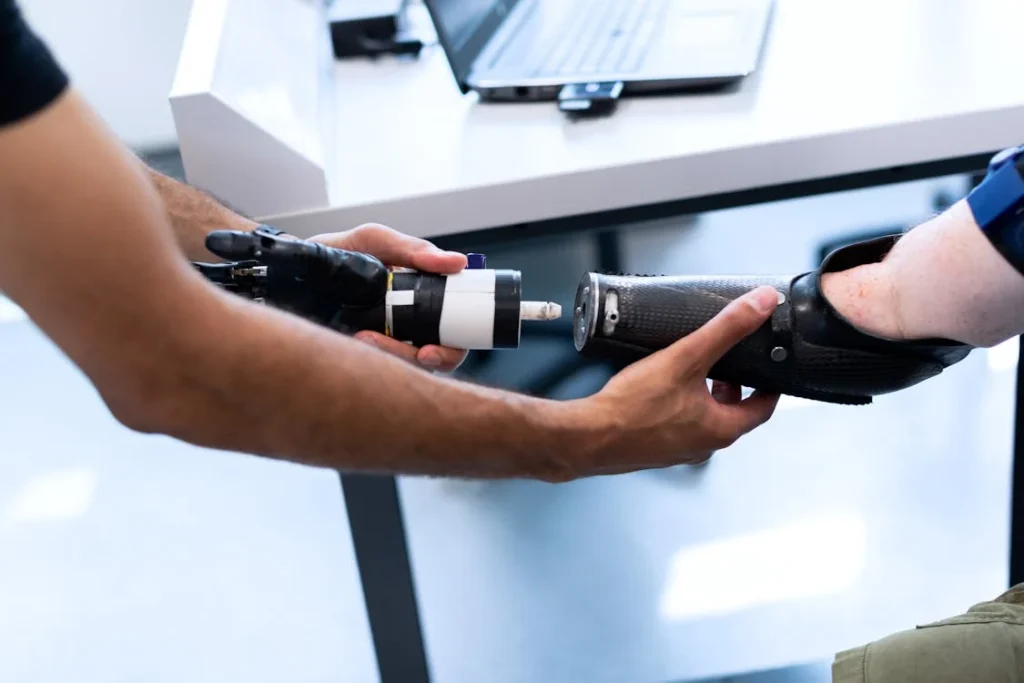
The Role of Regular Adjustments and Follow-ups
No prosthetic, no matter how advanced, can stay a perfect fit forever—especially for a child. That’s why ongoing adjustments are not just routine—they’re part of the journey. A child’s body is always changing, and so must the prosthetic that supports them.
These adjustments are more than just tightening a strap or adding padding. They are a careful process where prosthetists check alignment, comfort, and function.
Every tweak is designed to help the child move naturally and comfortably. Skipping these steps can lead to bigger problems later on, such as posture issues or pain.
What Happens During an Adjustment Session
At Robobionics and our partner clinics like Omnify Prosthetics, each adjustment session starts with a full check of the prosthetic and the limb.
We look at how the socket fits, whether the joints align well, and if the child’s range of motion is smooth. The skin is checked for any redness, sores, or pressure spots.
If the socket is too tight, it may need to be reshaped or remade. If the prosthetic limb seems too short compared to the other leg or arm, it may need lengthening.
For children using Grippy™, we also test the signal response from the sensors to make sure it is working well with the muscle activity.
Sometimes adjustments are small—like changing the padding or replacing a worn-out part. Other times, they may require a complete socket replacement.
Our goal is to make these changes quickly and efficiently so the child can get back to daily life without delay.
We understand how important it is for families to have fast and reliable support. That’s why we focus on local solutions.
Since Grippy™ is designed and manufactured in India, we can offer quicker services without the long wait times that often come with imported devices.
When to Schedule a Visit
Knowing when to come in for a check-up is key. While regular follow-ups every 4 to 6 months are recommended, there are moments when you should schedule a visit sooner.
If your child complains of discomfort, if you notice changes in how they walk or move, or if the limb shows signs of skin issues, it’s time to come in.
Kids who are especially active or going through a rapid growth phase might need more frequent visits. Some children may even need a new socket once or twice a year depending on how fast they grow.
It’s different for every child, and that’s why we personalize each care plan.
We keep digital records and 3D scan data so that we can track changes over time. This helps us predict upcoming needs and prepare for them.
Families appreciate this proactive approach, as it prevents emergencies and helps the child feel more secure.
If you’re unsure whether it’s time for a follow-up, contact us today and speak with a specialist.
A quick consultation can save your child from discomfort and make sure their prosthetic continues to support them as it should.
The Emotional Side of Adjustments
Adjustments aren’t just physical. They can affect a child’s emotions too. A change in how a prosthetic fits might make a child feel anxious, especially if they’ve gotten used to the way things were.
They might worry that the new fit will be harder to use, or that it will feel unfamiliar.
We make it a point to involve kids in the process. We show them what we’re doing, explain why the changes matter, and let them test it out right away.
This builds trust and gives them a sense of control. When kids understand what’s happening, they feel more confident using their prosthetic.
Parents can support this by staying positive and encouraging open communication. Let your child know that adjustments are a normal part of growing up with a prosthetic.
Help them focus on how these changes will make things better, not harder.
Our team also provides gamified home-based rehabilitation to help children adjust to their prosthetics in a fun and supportive way. These programs help train muscles, improve coordination, and make learning to use a new fit feel more like play than therapy.
Learn how gamified rehabilitation can improve your child’s prosthetic experience. Contact us today and ask about our home-based programs.
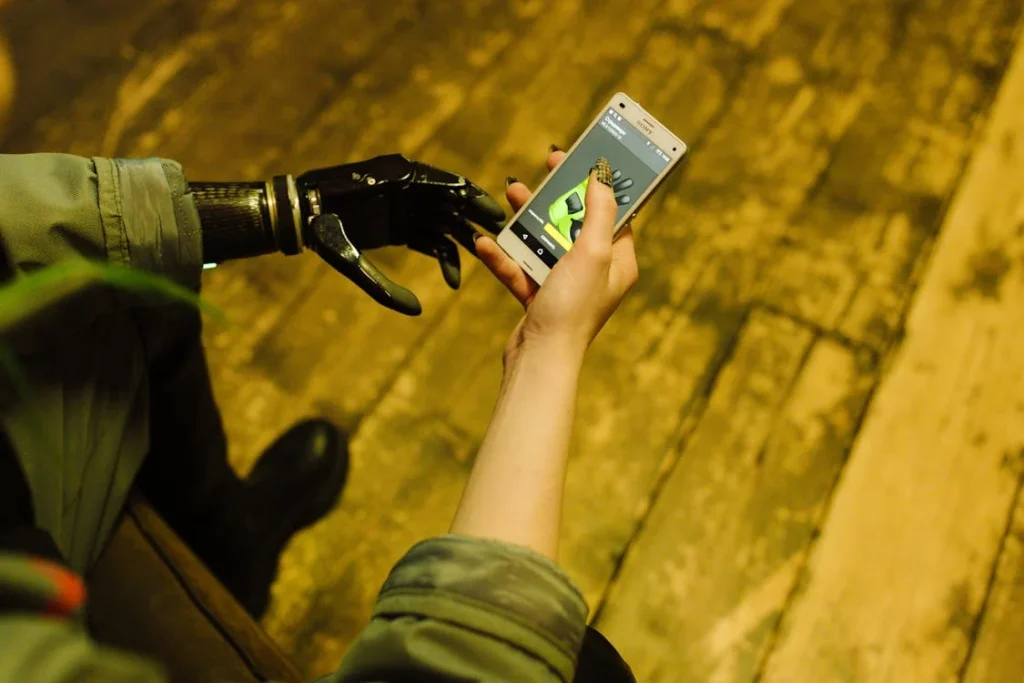
How Technology Makes a Better Fit Possible
Thanks to modern technology, prosthetics today are more advanced, more responsive, and more adaptable than ever before.
For children, this means a better chance at getting a prosthetic that not only fits well now but can grow and evolve with them over time. At Robobionics, we use a mix of engineering, design, and smart tools to make sure our prosthetics meet every child’s unique needs.
One of the biggest changes in recent years has been 3D printing. This allows us to create custom parts that match a child’s limb exactly. Instead of relying on guesswork or standard sizes, we take precise digital scans of the residual limb.
These scans are turned into a model, and from that, we build a socket that hugs the limb perfectly—no pressure spots, no slipping.
This level of accuracy makes a huge difference in comfort. A snug but gentle fit helps with movement, reduces the risk of skin issues, and allows the child to use their prosthetic with more ease and confidence.
And when a child grows, we can go back to those scans and compare. This helps us track growth patterns and plan the next steps more effectively.
Sensor-Based Myoelectric Technology
For upper-limb prosthetics like our Grippy™ hand, we also use myoelectric technology. This means the prosthetic moves based on muscle signals.
Small sensors inside the socket detect muscle activity when the child tries to open or close their hand. These signals are then converted into real movement in the prosthetic hand.
This setup helps kids feel more in control. It also makes the prosthetic feel like a natural part of their body rather than just a tool.
But for this to work smoothly, everything—from the socket to the sensors—must be aligned just right. Even a small shift in placement can lead to signal problems or slower response times.
That’s why we offer regular sensor calibration and socket realignment as part of our service plan. Whether your child is just starting out or has been using Grippy™ for a while, we’ll make sure the prosthetic keeps up with their body and their progress.
Easy Upgrades, Faster Repairs
Children are active by nature. They play, run, explore—and sometimes, that means wear and tear. A strong prosthetic should be able to keep up.
But when something breaks or needs replacement, waiting for parts from overseas can be frustrating.
Because our prosthetics are made right here in India, we can deliver faster repairs and easier upgrades.
Whether it’s a cracked joint, a worn-out strap, or a sensor that needs tweaking, we take care of it locally and quickly. No long delays, no stress.
This local support also means we can respond faster to growth needs. If a new socket is needed, we can design, print, and fit it—all within days, not weeks.
Parents can feel more at ease knowing their child won’t have to miss school or playtime waiting for help.
If you’re facing long wait times or repair issues with your child’s current prosthetic, let’s change that. Reach out to us for a consultation, and discover how Robobionics can support your family with speed, care, and cutting-edge technology.
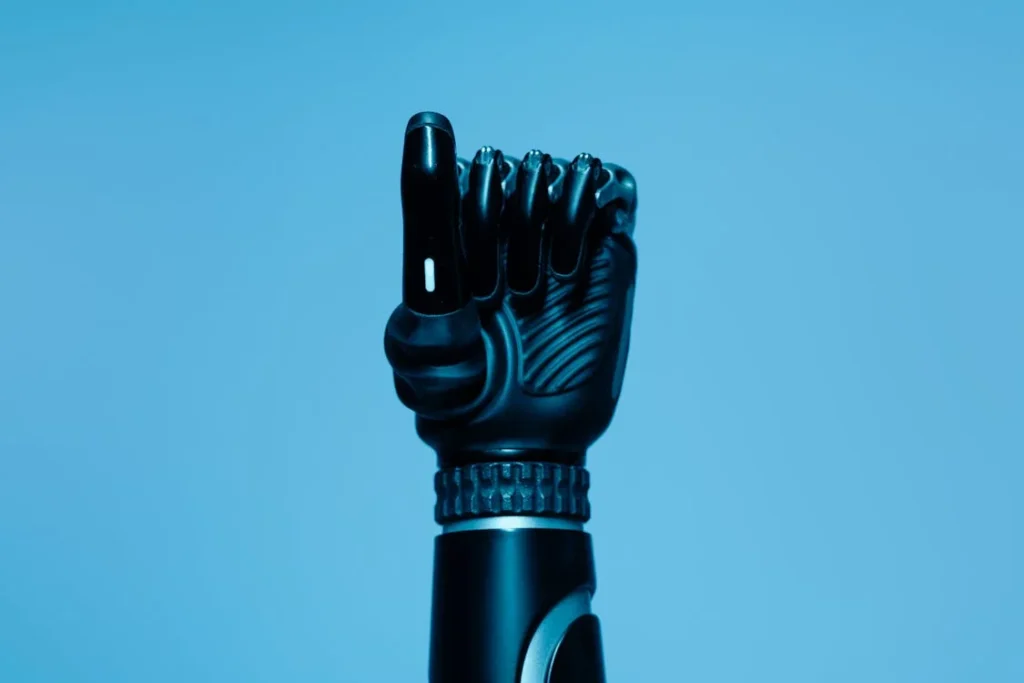
Making Daily Life Easier with the Right Fit
A well-fitted prosthetic isn’t just about comfort—it’s about freedom. For a growing child, it means being able to play with friends, attend school without discomfort, and do everyday tasks with ease.
When the fit is right, the prosthetic becomes part of their body, not a barrier.
But achieving that takes more than just good design. It requires careful attention to how the prosthetic works during a child’s daily routine. From brushing teeth in the morning to tying shoes or climbing stairs, every movement matters.
At Robobionics, we spend time understanding how each child lives, moves, and interacts with their world. This helps us design adjustments that actually improve daily life—not just fit better on paper.
School, Play, and Confidence
School is one of the biggest areas where a child’s prosthetic must support—not hinder—their success.
A poorly adjusted limb can cause fatigue, make writing difficult, or lead to awkward movements that make the child feel different from their peers. Over time, that can affect their confidence.
That’s why we talk directly with both children and parents about what’s working and what’s not.
Maybe the hand doesn’t rotate enough to pick up a pencil properly, or the leg feels heavy after sitting in class. These small details can have a big impact.
Our team works closely with families to fine-tune each part so the child can feel more independent in class, participate in games, and not worry about their prosthetic holding them back.
If your child struggles with day-to-day tasks, we can help you explore simple, proven adjustments that improve both function and confidence.
Building Good Habits Early
One of the most powerful ways to ensure a long-lasting, comfortable fit is to build good care habits early.
Teaching your child to care for their prosthetic, clean it properly, and speak up when something doesn’t feel right gives them a sense of control. It also helps catch small problems before they grow into big ones.
We always encourage parents to involve their children in the process. Let them help wipe down the limb, learn how the parts work, and understand when to ask for help.
These small lessons lead to better outcomes and a stronger bond between the child and their prosthetic.
At Robobionics, we provide easy-to-follow care instructions tailored for kids and parents. Plus, our support team is always ready to answer questions or guide you if anything changes.
If your child has outgrown their current fit, or you’re not sure whether an adjustment is needed, book a free consultation and we’ll walk you through it step by step.
Staying Active and Involved
An active child is a happy child. We’ve seen firsthand how the right prosthetic fit helps kids stay involved in sports, dance, hobbies, and more. When everything fits well, they stop thinking about the prosthetic—and just enjoy being a kid.
That’s the goal of every adjustment we make: to help your child move through the world freely and confidently. Whether it’s cycling with friends or holding a cricket bat, the right fit makes these moments possible.
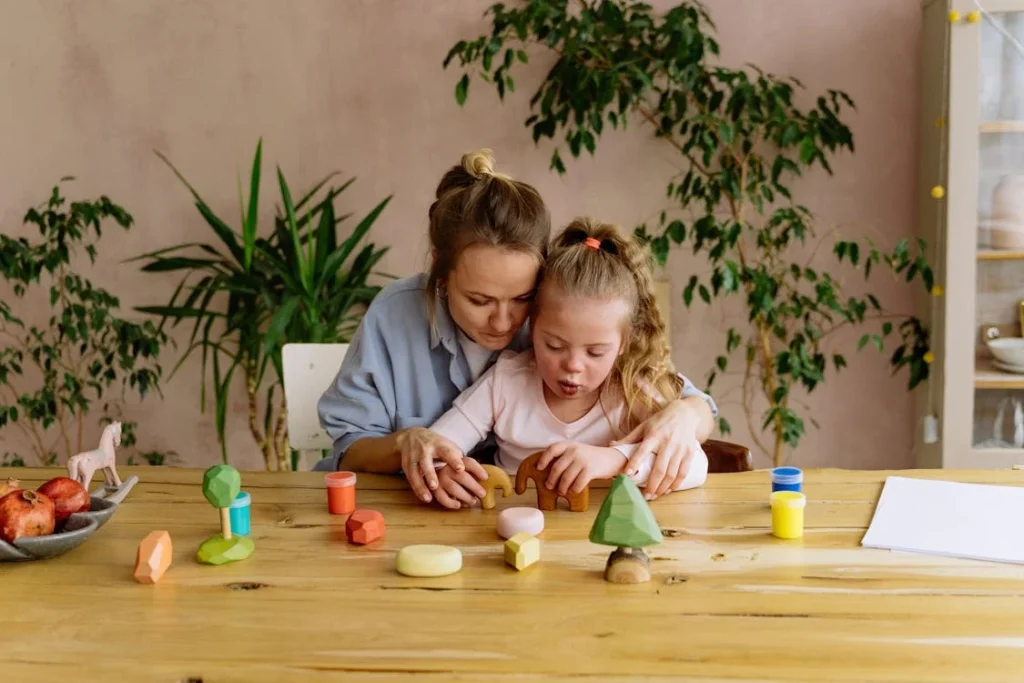
Parental Involvement: The Key to Long-Term Success
Behind every child learning to live confidently with a prosthetic is a parent or caregiver guiding them through the ups and downs.
While the prosthetic itself plays a major role in mobility, a parent’s involvement can be the real game-changer.
From tracking growth to helping with rehab, your support shapes how your child feels about their prosthetic—and about themselves.
Becoming a Partner in the Process
When your child first receives a prosthetic, everything is new—new routines, new tools, new emotions. At Robobionics, we encourage parents to think of themselves not just as caregivers, but as partners in the fitting process.
This means taking part in training sessions, attending follow-ups, and asking questions during fittings.
The more you understand the mechanics of the prosthetic—how it fits, how it moves, what to look out for—the better you can support your child in daily life.
Your input helps us adjust the prosthetic more accurately. You’re the one who sees how your child behaves at home, at school, and at play, so your feedback gives us valuable insight into what’s working and what isn’t.
We also provide guidance on how to spot early warning signs of a poor fit. If your child is favoring one leg, avoiding use of their bionic hand, or getting tired quickly, you’ll be the first to notice.
Knowing how to recognize these signs can help you take quick action before small issues turn into discomfort or injury.
Creating a Home Environment That Supports Progress
The work doesn’t stop after a fitting. A supportive home environment makes a huge difference. Encouraging your child to use their prosthetic daily, even in small tasks, helps them build strength, confidence, and independence.
Small wins matter—tying a shoelace, holding a spoon, or pushing a door open builds the habit of using the prosthetic naturally.
Children often look to their parents for cues. If you show patience, positivity, and encouragement, they’re more likely to stick with the process, even on tough days.
When setbacks happen—and they will—it’s your belief in their abilities that helps them push forward.
That’s why we equip parents with simple routines and gamified exercises that can be done at home. These activities are designed to be fun, low-pressure, and highly effective.
Building a Support Network
Another important step is connecting with other parents who are going through similar experiences. No one understands the emotional side of raising a child with limb loss quite like another parent who’s been there.
Whether it’s exchanging tips on adjustments or just offering moral support, this network can be a lifeline.
At Robobionics, we host community sessions and virtual parent circles to help you stay connected. You’ll hear stories of progress, share questions, and even get advice from parents whose children are thriving with prosthetics.
These aren’t just support groups—they’re opportunities to learn, grow, and stay empowered.
We believe that the more confident and informed you are, the more successful your child will be. Join our community of families who are taking this journey one proud step at a time.
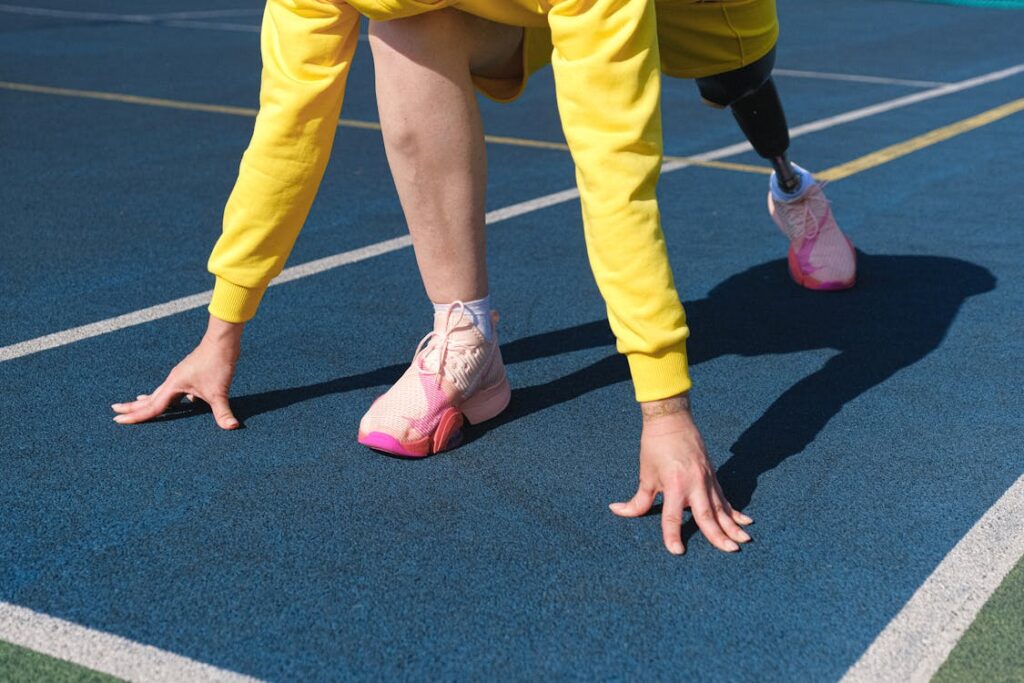
Preparing for Growth Spurts: Planning Ahead, Not Catching Up
One of the most challenging parts of fitting prosthetics for children is staying ahead of growth spurts. These can happen suddenly, and when they do, a perfectly fine prosthetic can start feeling uncomfortable overnight.
But with the right planning, you can stay one step ahead and avoid last-minute emergencies.
At Robobionics, we’ve developed systems to help families prepare for these rapid changes, rather than scramble to react when they happen.
By tracking growth patterns and building in flexibility, we make sure the prosthetic continues to support your child without unnecessary delays or stress.
Predictable Patterns, Personalized Plans
While no two kids grow the same way, there are some general patterns that prosthetists can use to predict when major changes are coming.
For instance, children often have growth spurts around age 6 to 8 and again during their early teen years. During these periods, their limbs can lengthen quickly, which affects how well the socket and limb components fit.
This is why we recommend scheduling check-ups slightly ahead of those age windows, even if there are no visible issues yet.
Our team uses limb measurements and previous socket data to map your child’s growth trends. With this, we can estimate when they’re likely to need their next adjustment—or even a completely new socket.
Planning ahead also gives us time to create a smooth transition. Instead of rushing to fix a socket that suddenly feels tight, we can start working on the next version early.
That means your child isn’t without their prosthetic while we make changes, and you’re not caught off-guard.
Modular Prosthetics: Growing with Your Child
One of the innovations we’ve embraced at Robobionics is modular prosthetic design. This means parts of the prosthetic—like joints, limbs, or sockets—can be swapped or upgraded without replacing the entire device.
For example, if a child’s leg length changes, we can often replace just the lower section without changing the knee or foot.
This approach is especially helpful for children going through frequent growth spurts. It reduces both cost and downtime. Plus, it’s more environmentally friendly, since we reuse as many components as possible.
Our Grippy™ hand, for example, uses modular sensors and parts that can be adjusted based on muscle growth or shifting limb shape.
If your child gains more control or strength, we can adapt the hand to match their new capability. And because it’s 3D-printed in India, parts are readily available—no weeks of waiting.
Getting Schools and Teachers Involved
Another great way to prepare for growth and change is to work closely with your child’s school. Teachers and staff often spend many hours with your child and may be the first to notice subtle signs that something isn’t quite right.
They might see your child hesitating to participate in sports, taking more breaks, or becoming distracted in class due to discomfort.
We offer support to schools and can provide simple guides or workshops for teachers so they can better understand how to support children with prosthetics.
When everyone is on the same page—parents, clinicians, and educators—it becomes much easier to stay ahead of changes and keep your child comfortable and confident.
Conclusion
Helping a growing child thrive with a prosthetic is not just about finding the right fit today—it’s about staying prepared for tomorrow. With regular adjustments, close monitoring, and open communication, you can make sure their prosthetic keeps pace with their growth, their goals, and their everyday life.
At Robobionics, we’re here to walk that journey with you. From advanced bionic solutions like Grippy™, to modular designs, local support, and gamified rehabilitation, we offer everything your child needs to feel confident and capable.
Whether you’re just starting out or looking to improve your current setup, our team is ready to help. Book a free demo of Grippy™ today, or schedule a personalized consultation to explore how we can support your child’s unique path.
Because every child deserves a prosthetic that fits—not just their limb, but their life.



